|
THE INVENTION OF THE
PENDULUM CLOCK
PART 1/5
The real story

(Type
Ctrl+F
to find any text on this page)
 PREFACE
PREFACE
One of the best documented inventions in history
is the invention of the pendulum clock. At the same time it is one of the
most disputed ones, especially so from the English side. For some reason
this invention is of such importance that continuously claims are launched
to appropriate it. We will represent here the real course of events, based
on facts, scientifically accepted sources, archival documents, circumstances
and events during the time of the invention.
The immediate reason to do this now is the magnificent and overwhelming
exhibition
‘Innovation
& Collaboration
The early development of the pendulum clock
in London’
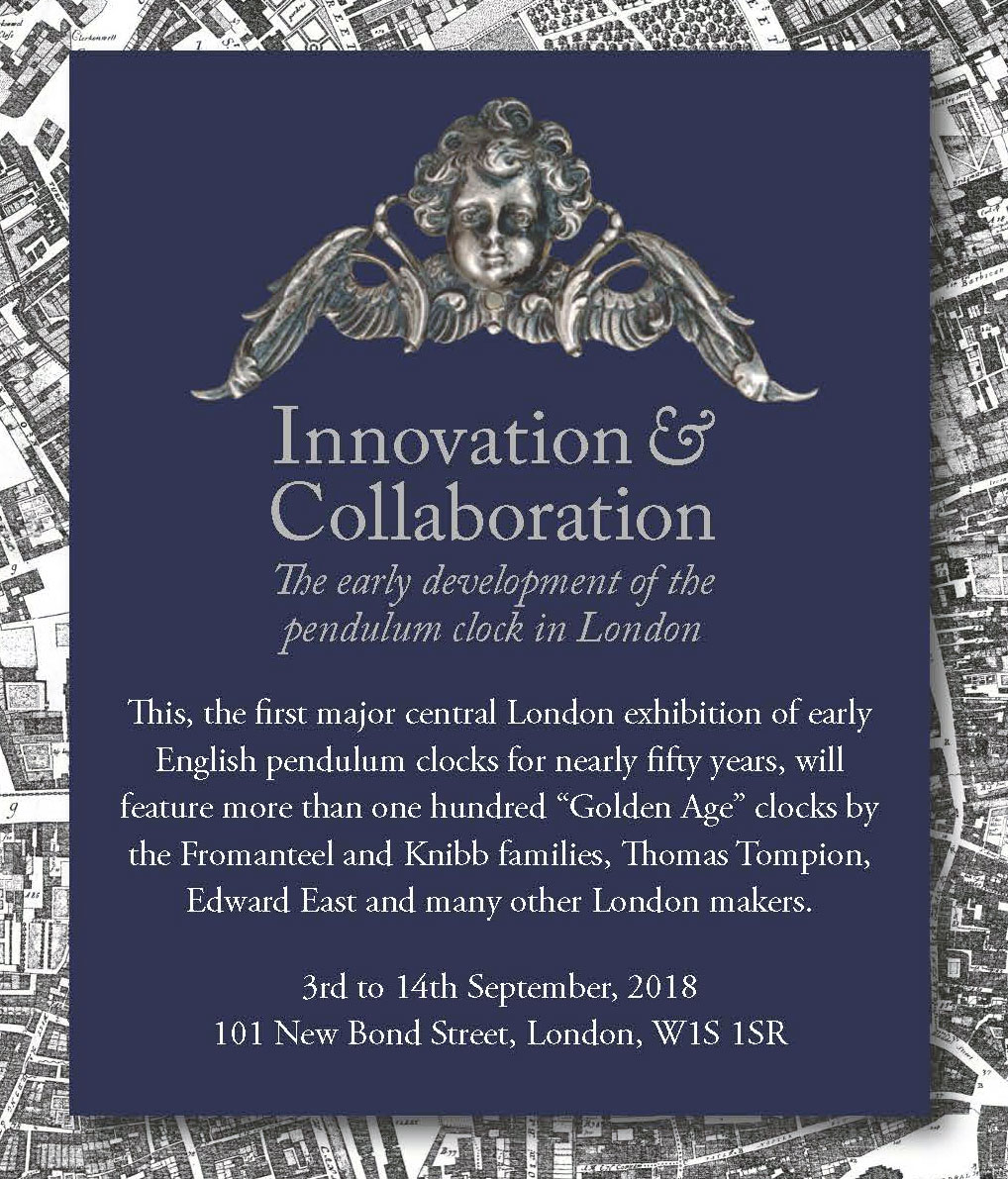
held at Bonhams in London between 3 and 14 September 2018; and
particularly the catalogue published on the occasion of the exhibition.
Where the exhibition exceeded all imagination on visualising early clock
making in England, the catalogue falls short of any sense of reality.
An
actual falsification of history is presented, based on half-truths,
interpretations, speculations, suggestions and simply untruths.
Four quotes form the basis of our criticism and
illustrate the above allegations: Four quotes form the basis of our criticism and
illustrate the above allegations:
“And if
credibility is given to the revised succession of events advanced at this
exhibition, namely that Fromanteel was working on pendulum deployment with
Christiaan Huygens from at least 1656, then by the time of the pendulum's
commercial launch in autumn 1658, marked by the distribution of Huygens's
Horologium in September (Cat.
25) and Fromanteel's advertisement in October, Fromanteel would have passed
the development stage and would have worked through a number of stages of
movement design and layout.”
(2
“A central
revisionary tenet of this exhibition, namely that John Fromanteel,
notwithstanding that he was technically still an apprentice, arrived at
Coster’s in The Hague in September 1657 to teach (rather than be taught by)
the Dutchman the mysteries of pendulum clock making, …”
(3
“Under the
new interpretation advanced in this exhibition, in which Huygens the
inventor employed Ahasuerus Fromanteel, as the practical technician, to
develop, construct, and perfect working models incorporating the Dutchman’s
pendulum invention for the domestic market (as opposed to scientific
market), it would seem expected, rather than merely coincidental, that the
cases of the earliest pendulum clocks made in London and The Hague were so
similar.”
(4
There are
many unfounded and unverified theories published in the last decades, but,
as Christiaan Huygens himself wrote to the Lords of the States of The
Netherlands when publishing Horologium in 1658:
“It is
certain that elsewhere also will arise men, who will envy our little fame
and perhaps try to convince themselves, but certainly the whole world,
that this invention is not due to
the acuteness of our compatriots, but rather long before was brought to
light by the zeal of themselves or one of their own”
(5.
In this article we will set out the real story of
the invention of the pendulum clock, based on all currently known sources.
We will do this by discussing the main
characters: Christiaan Huygens as inventor, Ahasuerus Fromanteel I, the
maker of the first pendulum clocks in England; his eldest son John
Fromanteel; Salomon Coster, maker of the very first pendulum clock; the
‘Contract’ between Salomon Coster and John Fromanteel. And also by
reproducing the historical context and developments, situations, sources,
artifacts, clocks and how it all fits together.
All data will be discussed in chronological order
as much as possible, but sometimes we have to jump back- or forward because
of simultaneous developments in Holland or England. Obviously the playing
field of the invention of the pendulum clock is much wider than discussed
here, especially in relation to the developments between Holland and France
and in France itself, but this part of the story is omitted here on purpose.
 INTRODUCTION
INTRODUCTION
The start of the 80 year war
between Spain and The Northern Dutch Provinces and especially the
capture of Antwerp in 1585 by the Spanish troops, caused a stream of
protestant ‘Flemish’ refugees to the north, but also a large group
crossed over to England. Among them were the ancestors of Ahasuerus
Fromanteel, who was born in Norwich in 1607
(6.
In 1631 Ahasuerus joins the Blacksmiths’ Company, and in 1632 he
becomes ‘Free brother’ with the newly founded Worshipful Company of
Clockmakers. (7
He seems to have set up a flourishing
workshop as instrument maker and lens grinder;
he
also produced clocks
commissioned by other
makers.
(8
We do not know exactly when Salomon Coster is born.
Coster was a Mennonite, so there is no birth certificate. Several
sources mention a date of 1622, which is an accepted guess by
subtracting 21 years
(9
from his
marriage date: Coster married Jannetje Harmens on March the 22nd,
1643
(10.
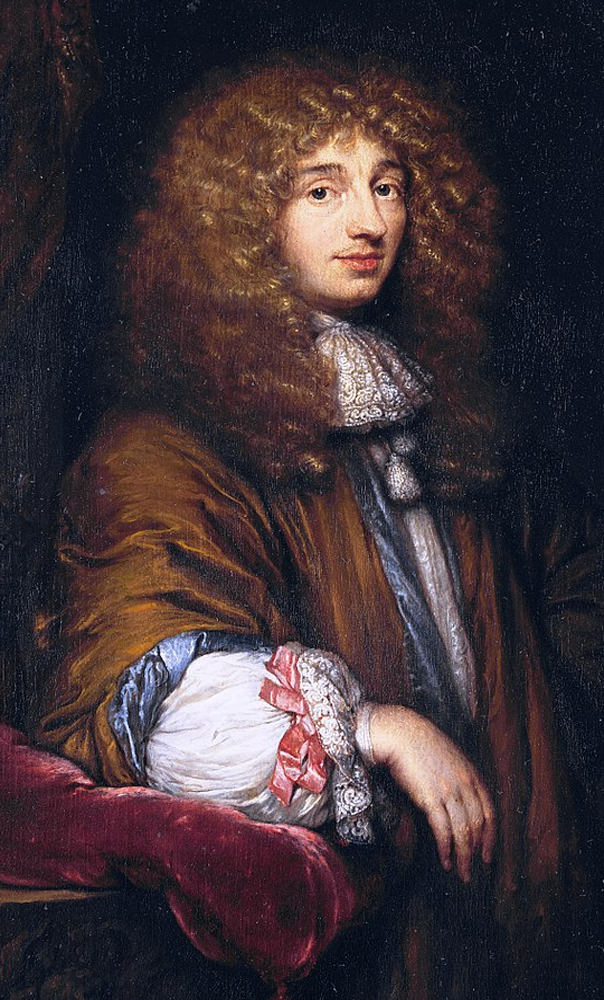
Christiaan Huygens 1629-1695
Christiaan Huygens was born 14 April 1629, in
a prosperous and distinguished family living in The Hague. His
father, Constantijn Huygens (1596-1678), was a diplomat, secretary
to the Princes of Orange, and also a poet and a composer. Christiaan
had one older brother, Constantijn jr., two younger brothers and a
younger sister.
Christiaan studied law and mathematics at
Leiden University from 1645 to 1647, amongst others with the
stimulating mathematician Frans van Schooten, with whom he would
continue to correspond intensively until the death of the latter in
1660. After his time in Leiden Christiaan and his younger brother
Lodewijk continued their education at the ‘Breda College of Orange’,
the Illustrious school and Collegium Auriacum, where his father was a
curator(I.
As early as in 1649 Huygens
publishes his first scientific work on hydrostatics. In the following
years Huygens focuses on multiple mathematical issues (calculation of
the length of curves and quadrature (area) of hyperboles, ellipses and
circles), physical issues and astronomy (Jupiter's Moons, Saturn's
Rings).
(11
Johannes (John) Fromanteel is born ca. 1638 and first becomes
apprenticed by his father.
The notes of the Worshipful Company of Clockmakers
of 5 April 1652 indicate, that
‘John
Fromanteel before the Court is bound to Ahasuerus Fromanteel as
apprentice’. On 5 April 1659 ‘John
Fromanteel becomes journeyman’ and on 6 July 1663 ‘John
is freed and becomes Freeman’.
(12
 CORRESPONDENCE
CORRESPONDENCE
In the run up to the
publication in 1656 of Wallis’ book
Arithmetica infinitorum,
Christiaan Huygens and John Wallis have an extensive correspondence between June
1655 and September 1656.
The
last letter of Wallis to Huygens is from 22 August 1656 and Huygens’ answer to
Wallis is from September 1656. No mention at all in the entire correspondence of
anything horological. At this moment Wallis is the only Englishman Huygens is
corresponding with.
(13
It takes over two years for another letter from John to Christiaan.
(14
Confirmed by recently
rediscovered and published information from English archives Ahasuerus
Fromanteel I appears to have developed more and more into a technical instrument
and apparatus maker. He produces pumps and fire engines, but also telescopes,
boxes, lenses, hydrometers, blown glass 'laboratory' tools, automata, dredgers,
etc. etc. Beside all this he also makes clocks.
(15
From the
correspondence of Samuel Hartlib we now know that in the 1650’s Fromanteel is
concentrating on the duration of clocks and their running as accurately as
possible. In Fromanteels’ catalogue or list we can order ‘A
watch or standing clock to goo a weecke or a month or a year with once winding
up and yet to goo as true as one that is wound up every day’. He even makes
a ‘rolling ball clock
(16.
In 1657 we read
‘… A clock of Fromantils
… his new invented Clock of Motion to goe without being wound up a weeke or
month or longer’.
(17
Later the same year there is an announcement that ‘Fromantil
hath made a clock that needs not be wound up within a month’.(18
Ahasuerus Fromanteel I receives the Freedom of the City of London on 14 January
1656 and subsequently, after intervention of Cromwell, the Lord Protector, also
the Freedom of the Clockmakers’ Company. Only then he is allowed to make, sign
and sell clocks himself in the City of London.
(19
In the period before the invention of the pendulum
clock Christiaan Huygens is primarily concerned with mathematics and astronomy
(see the correspondence in Oeuvres
Complètes). He is mainly corresponding with people in Holland and France,
like Frans van Schooten, Claude Mylon, Blaise Pascal, Gilles Personne de
Roberval, Johannes Hevelius, Jean Chapelain.
(20
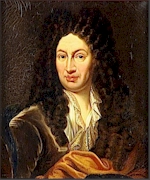
Jean Chapelain
Between 28 June and 19 December 1655
Christiaan is in Paris, together with his brother Lodewijk and cousin Philips
Doublet (21.
All 1656 and 1657 he is residing in Holland (The Hague)
(22
On 25 December 1656 Christiaan Huygens has his Eureka
moment by finding the application of the pendulum to the clock. On 26 December
of the next year, he writes in a letter to Ismael Boulliau ‘Yesterday
it was exactly a year ago that I made the first model of this type of clock…’.
(23
In a letter of the 12th of January 1657 to his tutor
the mathematician Professor Frans van Schooten we read ‘These
days I found the construction of a clock of a new generation, with times so
exact as the diameter, with its help I have no small hope to be able to
determine the longitude at sea’.
(24
Christiaan writes to Claude Mylon on 1 February 1657
‘I will also share with him a new
invention, that must be of great use in astronomy, and that I hope to
successfully use finding the longitudes. You will hear of it soon.’ With him
is meant Monsieur Bulliaut - Ismaël Boulliau, at that moment secretary of the
French ambassador in The Dutch Republic.
(25

Ismaël Boulliau
Claude Mylon writes back to
Christiaan on 12 April 1657 that his invention of the clock is found very
beautiful by all whom he has told about it, and this will be even more so if
Huygens can make it independent of weight or spring. Then nothing would stand in
the way of solving the problem of longitude.
(26
On 18 May 1657 Claude Mylon writes
Huygens again that he is glad that Huygens is continuously perfecting his clock
further, he fervently hopes it will be just as good at sea as in the room, and
changes from dry to humid do not change it more than the change in weights.
(27

Salomon Coster’s advertisement in the
Tijdinghe 51, December 1657.
Boxing Day 1657 Christiaan Huygens asks Boulliau, by
then back in Paris, more details about the clock Ferdinando de' Medici, Grand
Duke of Tuscany allegedly had made, which shows a resemblance to Huygens’
invention, and whether this clock also has a pendulum.
This is the same letter in which Huygens tells it was
exactly a year ago he made the first model of a pendulum clock, and started in
June to show everyone interested the construction. He also writes he is busy
with the conversion of the turret clock in Scheveningen. The pendulum is almost
seven meters long (21 feet) and weighs approximately 20 kilo’s (40 or 50
pounds). By now he also urges Boulliau not to do anything in Paris, not by his
own instructions or by anyone else’s …(28
Subsequently Huygens writes on 13 June 1658 in
another letter to Boulliau he wants to apply for a patent in Paris as well. The
application is prepared by the French ambassador in The Hague, so Boulliau can
present it to the French Chancellor.
(29
One week later (21 June) Boulliau answers Huygens that the French Chancellor
Seguier has refused his request up to three times, as he does not want all
French clockmakers coming after him screaming.(30
On 16 July 1658 Simon Douw applies for a patent for
‘his own invention’. Huygens and Coster together file a lawsuit against Douw(II
because of
infringement of their patent.(31
On 6 September
Huygens sends ‘Horologium’ to more
than 60 scientists at home and abroad.(32
The list includes two copies for Salomon Coster. Fromanteel is not on the list.
From the foregoing we can conclude Christiaan Huygens
had a number of possible reasons to publish
Horologium:
Rumours of a
pendulum clock in Tuscany, the claim Galileo had invented this and Treffler made
a clock following this principle.
The application for a patent by Douw and the process
against him.
Refusal of the French Chancellor Seguier to grant
Huygens his patent for the pendulum clock.
In the
meantime, on 16 June 1657 Coster gains the privilege by the States General of
the Dutch Republic. This means he is the only one allowed to use and sell a
pendulum clock, invented by Christiaan Huygens and made available to Coster, in
the Dutch Republic for a period of 21 years.(33
This is officially ratified by the States of Holland and West-Friesland, the
most important province, on 16 July 1657.(34 Huygens tells us later this is
also the time he starts showing the construction to everyone interested.(35
On 3 September
1657 the ‘Contract’ between John Fromanteel (then still apprenticed to his
father) and Salomon Coster, Master Clockmaker, is signed.(36
The agreement runs until
May (meydage) 1658. Afterwards John
returns to London.
Hartlib mentions in the early summer of 1658:
‘A Clock newly invented in the Low Countries that
need only once to bee wound in 7 days and hath not failed to go exactly for many
months together. It is made without a balance so that it will never change by
any weather? Fromantil hearing of it, is endeavouring to make the selfe-same
Clock. His clock presented to my Lord Protector is returned upon his owne
hands'.(37
On 3
June the same Hartlib mentions in a letter to Robert Boyle
(Irish
philosopher and chemist/alchemist):
'Sir Robert Honeywood, lately arrived out of the Low
Countries, tells of a singular invention found out there, of a clock that goes
most exactly true without a balance, which needs not to be wound up but once in
eight days, the price being 7lb sterling. Mr Palmer, who hath a shop as it were
of all manner of inventions, is to have one shortly: and Fromantile hearing of
it gives out confidently, that he is able to make the like, or rather to exceed
it'.
(38
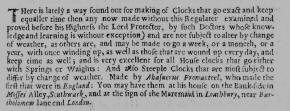
Fromanteel's advertisement October 1658
On 28 October 1658 Fromanteel publishes his famous
advertisement in the Mercurius Politicus
about the availability of a new type of clock. Right below this advertisement,
there is a second one in which he recommends his new pump, that not only can
quench fire, but also can spray pests from trees and hops, watering the gardens,
clothes and the like.
(39
As already
mentioned, the agreement between John Fromanteel and Salomon Coster is
signed on 3 September 1657. At this time John is
still apprenticed to his father for five
years and is 19 years of age. Next to care for his employee (beer, fire
and light), as a good employer should, to make his employee as
productive as possible, Coster will pay John 20 Guilders for every
completed piece of work and no more than 18½ Guilders if Coster supplies
the copper and steel.
(40
The Coster/Fromanteel contract does not give any information about
what type of timepiece is meant by horologien, because further
specification is lacking.
(41
Pieter Visbagh, another renowned Dutch
clockmaker, is apprenticed to Coster from 1 May 1645 onwards for nine
years. This is documented in the learning agreement between them,
drafted and signed almost a year later, on 31 January 1646. It is agreed
that during the first three years of the agreement Pieter is not
residing at Coster’s. After these three years Coster will provide board
and lodging. In the 8th year Pieter will additionally receive
a wage of 100 Guilders, doubled to 200 Guilders the next and last year.
At the end of this apprenticeship Pieter is 21 years of age.
(42
In the learning agreement of
Christiaan Reijnaert, aged 12 at the start (November 1655), we read:
“…
to live with and taken care of by the same, through food, drink,
clothing, clean washing, everything that is needed for nourishment”
(III.
Coster will receive from the uncles of Christiaan 50 Guilders for the
entire apprentice period of ten years. After completion of these ten
years of apprenticeship Christiaan is not sent away just like that. He
receives from Coster 100 Guilders and as much clothing as belongs to a ‘moral
trousseau’.
After Salomon Coster’s death, when
Pieter Visbagh takes over the workshop, he will also take over this
agreement.
(43
 CONCLUSIONS
CONCLUSIONS
From the above
mentioned historical resources, we learn that Christiaan Huygens is in
The Hague all of 1656 and 1657. Ahasuerus Fromanteel I is the entire
same period in London. We know Ahasuerus’ son John was also in The Hague
from 3 September 1657 until 1 May 1658. However no correspondence, no
connection and no other proof of anything else between Huygens and the
Fromanteels can be found. The name Fromanteel does not occur even once
in one of the first four volumes of
Oeuvres Complètes (spanning
1638-1663). In contrast other ‘craftsmen’ are mentioned by Huygens
frequently:
● OC Huygens Vol.2
(1657-1659), pages:
Coster (Salomon).
125, 209, 235, 236, 241, 244, 245, 246, 247, 272,
281, 289, 290, 291, 314, 317, 327, 331, 372, 382, 419, 420, 439, 440,
473, 483, 486, 527, 540.
Hanet. 281, 294, 319, 372, 381, 382, 419, 454,
473, 483, 486, 527.
● OC Huygens Vol.3
(1660-1661), pages:
Coster
(Samuel). 4, 11, 84
Coster (Veuve Samuel)
à
Hartloop (Jannetje Hartmans) 4, 98, 284.
Hanet. 4, 8, 10, 16,
19, 23, 25, 50.
Treffler (Filippus). 483, 484.
● OC Huygens Vol.4
(1662-1663), pages:
Hooke (Robert).
218, 221, 275, 320, 359, 366, 437,438.
Oosterwyk (Severyn). 324, 411, 418, 424, 430, 434, 452, 456, 460, 477,
478.
Thuret. 110, 270.
If Fromanteel would have been involved in the very
early development of the pendulum clock, right after the invention, some
reference should have been found in the very extensive collection of
correspondence of Christiaan Huygens in
Oeuvres Complètes or in the
Dutch and English Archives.
Even if an apprentice of 19 years
of age, John Fromanteel, needed a period of 8 months to explain how to
make a pendulum clock to Salomon Coster, more than 12 years a Master
Clockmaker, where did John Fromanteel get this knowledge? His father?
Without any demonstrable connection to Christiaan Huygens?
There is
only the ‘Contract’ between John Fromanteel and Coster, which is not
much different from any of the other learning or apprenticeship
agreements. It also does not differ much from and is very comparable
with a modern internship towards the end of a training, with the benefit
for Coster of an already more experienced assistant and for Fromanteel
to learn about the new sensation: the pendulum clock.
By all
means, Fromanteel seems too commercial, certainly in view of his list
and the advertisements, to settle only for the very minimal and even
nowadays unknown and unproven benefit of scientific satisfaction. Was it
not just the information his son John brought back from The Hague, that
he needed to make a pendulum clock?
Do we not get a very logical
sequence of events, also substantiated by all historical sources: End of
‘Contract’ in May 1658 à John and Ahasuerus build their own version of
the pendulum clock during the summer
à
Huygens publishes and circulates Horologium in September 1658
à
Fromanteel publishes his advertisement in October 1658.
Huygens’
invention of the pendulum clock, in the form of Coster clocks, spreads
at a tremendous ‘commercial’ pace all over Europe, well before the
advertisement by Fromanteel. We know that before the end of 1657 a
‘Coster clock’ is in Tuscany. In an inventory of 1690 a clock signed by
Coster is mentioned to have arrived on 25 September 1657, as the first
pendulum clock in Italy. Treffler used this clock as example to make his
own. The movement of this latter clock is still existent today.
(44
From
Huygens’ correspondence we know a great many pendulum clocks are shipped
from The Hague to Paris, mainly by mediation of Nicolas Hanet.
We
know nothing, no clock or movement, description, correspondence, nor any
other source or anything else that would give a reason to put the very
first development of the pendulum clock with Fromanteel. There is no
direct proof at all. Moreover, any activity regarding pendulum clocks
from Huygens and/or Holland to England dates only after 1660, when the
trials with pendulum clocks at sea start. Christiaan Huygens comes over
to England for the first time in 1661.
(45
Only on this trip, in 1661, Christiaan visits the workshop of
Fromanteel, together with John Evelyn.
(46
But even then several of
these ‘regulators’ are being imported from The Hague to England.
(47
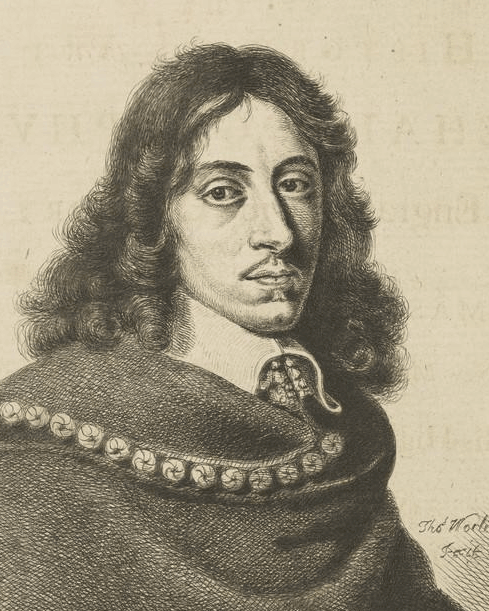
John
Evelyn
On the
other hand we know Coster and Huygens immediately after the invention
started to work on further improvements and applications of the pendulum
clock. One of their common projects is the turret clock of the church in
Scheveningen. On Boxing Day 1657 Huygens indicates he is working on the
conversion of the clock.
On 23 January 1658
Coster writes to Huygens that he is busy working on the clock in
Scheveningen, the clock has run all night, the pendulum weight is 50
pounds, but Coster wants to make several changes, as the movement runs a
quarter of an hour slow in 14 hours. He will take a look again next day.(48
Of the currently known early
pendulum clocks, none, neither from Coster nor from Fromanteel, are
‘scientific’ clocks. The earliest known clocks with a ‘three foot
pendulum’ all have a ‘scientific dial’ (large minute ring, small hour
ring, and a (small) seconds ring) all date from around or just after
1670, when this layout was first seen on the second edition of sea
clocks. The movements of all these scientific clocks are all in line
with the design presented in letters from Huygens around that time and,
a bit later, also published in Horologium Oscillatorum. The well-known
drawing exactly represents the layout of the movement of all presently
known clocks of this type.
(49
The movement of
Huygens’ own clock, signed Thuret
à Paris, currently in the collection of Museum Boerhaave, fully
meets this requirement.
Again, no sign of Fromanteel being involved in any of this; never does
he anywhere claim the invention. He also never applies for a patent in
England.
endsection
Also the
connection between the Huygens family and Ahasuerus Fromanteel through
Cornelius Drebbel is unlikely and illogical. Constantijn Huygens sr. and
Drebbel have met when they were both in London in 1621/22.(50
As a result Huygens sr. developed and kept a more than average interest
in Drebbel’s inventions. In 1622 Fromanteel was only 15 years of age,
while Christiaan was not even born.
Drebbel died in 1633. From the
‘Hartlib Papers’ we know no more than that Fromanteel once made a box
for Drebbel’s lenses and later started to make lenses himself.(51
No
more, no less. Even more far-fetched is the claim Fromanteel was in
Prague with Drebbel to study German clock making. When we know for
certain Drebbel was in Prague in 1610, Fromanteel was only 3 years of
age, far too young to show already any signs of a promising clockmaker.
Later trips are nowhere confirmed and also then Fromanteel would not
have reached the apprentice age yet. Anything here is purely
speculative.
Both father and son Huygens do not mention the name Fromanteel anywhere
in their extensively recorded correspondence. Once again any relation is
purely speculative.
End
of this section, click
here to continue.

 NOTES NOTES
|
|
|
|
I |
A member of the Supervisory Board of a higher educational institution. |
|
II |
Simon Douw (ca.1620-1663) 'Horlogiemaecker der Stadt Rotterdam',
clockmaker of the city of Rotterdam. Amongst others he built the
movement for the clock of the Rotterdam Exchange (1660-1663) and
converted the turret clocks of the 'Geertekerk' in Utrecht (1659) and
the 'Grote Kerk' of Dordrecht (1663) to pendulum. |
|
III |
“te woonen ende van denselven besorcht te werden van cost, dranck,
cleedinge, ende reyne bewassen, bewrevingen, alle ‘tgeene wes tot
onderhout sal vereisschen” |
|
|
|
|
1 |
Richard Garnier & Leo Hollis, "Innovation & Collaboration, The early
development of the pendulum clock in London", 2018, 63 |
|
2 |
Richard Garnier & Leo Hollis, "Innovation & Collaboration, The early
development of the pendulum clock in London", 2018, 70 |
|
3 |
Richard Garnier & Leo Hollis, "Innovation & Collaboration, The early
development of the pendulum clock in London", 2018, 83 |
|
4 |
Richard Garnier & Leo Hollis, "Innovation & Collaboration, The early
development of the pendulum clock in London", 2018, 84 |
|
5 |
Christiaan Huygens, "Horologium", Preface, Translated from Latin:
Tijdschrift voor Horlogemakers, 1e Jaargang No.5 1 Maart 1903 |
|
6 |
Anita McConnell,
"Fromanteel, Ahasuerus (bap. 1607, d. 1693)", Oxford Dictionary of
National Biography, Oxford University Press, 2004, online reference /
Richard Garnier & Leo Hollis, "Innovation & Collaboration, The early
development of the pendulum clock in London", 2018, 72 |
|
7 |
Brian Loomes, "Country Clocks and their London origins", 1976, 34-35 |
|
8 |
Hans Kreft, "Rediscovering the Fromanteel Story", article in the Dutch
Kunst & Antiekjournaal (August 2003), lecture at Schoonhoven NL
(September 2003), published Horological Foundation website, where
translated and adapted by R.K.Piggott. |
|
9 |
Marriage certificate Salomon Coster - Jannetje Harmens, Gemeentearchief
Delft, Collection DTB nr. 14, inv. 125, fol 109, Archive research and
transcription performed by Victor Kersing and Rob Memel. |
|
10 |
Victor Kersing en Rob Memel, "Salomon Coster, de Haagse periode",
lecture AHS-DS 10 May 2014; article Tijdschrift 4, December 2014 |
|
11 |
Charlotte Lemmens, Constantijn & Christiaan, "Een Gouden Erfenis - Het
leven van Christiaan Huygens 1629-1695", 139-159 |
|
12 |
Jeremy Lancelotte Evans, "Clockmakers’ Company Masters and their
Apprentices.", Transcribed from Atkins’ list of 1931, 56. |
|
13 |
Oevres Complètes de Christiaan Huygens, Tome Premier, correspondance
1638-1656, Martinus Nijhoff, 1888 |
|
14 |
Oevres Complètes de Christiaan Huygens, Tome Deuxième, correspondance
1657-1659, Martinus Nijhoff, 1889, No. 497 |
|
15 |
Rebecca Pohancenik, "The Intelligencer and the Instrument Maker: Early
communications in the development of the pendulum clock", Antiquarian
Horology, Volume 31 no 6, (December 2009), 750. |
|
16 |
HP 71/19/1A. In this article I made use of the work and the article of
Rebecca Pohancenik, "The Intelligencer and the Instrument Maker: Early
communications in the development of the pendulum clock", Antiquarian
Horology, Volume 31 no 6, (December 2009), 756. |
|
17 |
HP 29/6/1A-12B. In this article I made use of the work and the article
of Rebecca Pohancenik, "The Intelligencer and the Instrument Maker:
Early communications in the development of the pendulum clock",
Antiquarian Horology, Volume 31 no 6, (December 2009), 753. |
|
18 |
HP 29/6/13A. In this article I made use of the work and the article of
Rebecca Pohancenik, "The Intelligencer and the Instrument Maker: Early
communications in the development of the pendulum clock", Antiquarian
Horology, Volume 31 no 6, (December 2009), 753. |
|
19 |
Brian Loomes, "Country Clocks and their London origins", 1976, 38-39 |
|
20 |
Oevres Complètes de Christiaan Huygens, Tome Premier, correspondance
1638-1656, Martinus Nijhoff, 1888 |
|
21 |
Oevres Complètes de Christiaan Huygens, Tome Premier, correspondance
1638-1656, Martinus Nijhoff, 1888, p. 335 note 1 and Oevres Complètes de
Christiaan Huygens, Tome Quinzième, Observations Astronomiques.
1658-1666, Martinus Nijhoff, 1925, p. 193 |
|
22 |
Oevres Complètes de Christiaan Huygens, Tome Premier, correspondance
1638-1656, Martinus Nijhoff, 1888 |
|
23 |
Oevres Complètes de Christiaan Huygens, Tome Deuxième, correspondance
1657-1659, Martinus Nijhoff, 1889, No. 443 |
|
24 |
Oevres Complètes de Christiaan Huygens, Tome Deuxième, correspondance
1657-1659, Martinus Nijhoff, 1889, No. 368 |
| 25 |
Oevres Complètes de Christiaan Huygens, Tome Deuxième, correspondance
1657-1659, Martinus Nijhoff, 1889, No. 370 |
|
26 |
Oevres Complètes de Christiaan Huygens, Tome Deuxième, correspondance
1657-1659, Martinus Nijhoff, 1889, No. 382 |
|
27 |
Oevres Complètes de Christiaan Huygens, Tome Deuxième, correspondance
1657-1659, Martinus Nijhoff, 1889, No. 388 |
|
28 |
Oevres Complètes de Christiaan Huygens, Tome Deuxième, correspondance
1657-1659, Martinus Nijhoff, 1889, No. 443 |
|
29 |
Oevres Complètes de Christiaan Huygens, Tome Deuxième, correspondance
1657-1659, Martinus Nijhoff, 1889, No. 490 |
|
30 |
Oevres Complètes de Christiaan Huygens, Tome Deuxième, correspondance
1657-1659, Martinus Nijhoff, 1889, No. 492 |
|
31 |
Oevres Complètes de Christiaan
Huygens, Tome Deuxième, correspondance 1657-1659, Martinus Nijhoff,
1889, Appendice IV bij No. 523 |
|
31 |
Oevres Complètes de Christiaan
Huygens, Tome Deuxième, correspondance 1657-1659, Martinus Nijhoff,
1889, Appendice IV bij No. 523 |
|
32 |
Oevres Complètes de Christiaan Huygens, Tome Deuxième, correspondance
1657-1659, Martinus Nijhoff, 1889, No. 511 |
|
|
|

|
 Back to end of previous section.
Back to end of previous section.
 THE CLOCKS
THE CLOCKS
The early pendulum clocks still
existent today are all of the same, nowadays well known type. A
wooden case with a single chapter ring and central hour and minute
hands.
In Holland we see a continued adherence to the principles of
the first clocks, one single barrel for both going and striking train, a
velvet covered dial plate, signature below the chapter ring (creating a
rectangular dial plate) on a tip-up signature shield hanging over an
access hole in the dial plate for starting the pendulum. The pendulum is
suspended from a small wire and trapped in a crutch connected to the
verge escapement. The entire movement is hanging on the dial plate which
turns out to the front, there is no backdoor.
In England, fairly
quickly after the invention makes the crossing, there is an independent
development. There is no velvet on the square dial plate. We see
spandrels in the corners around the chapter ring and a quick return of
the use of a fusee next to the spring barrel, in combination with a
pendulum directly fixed to the verge. The signature is engraved directly
on the dial plate. The movement will almost immediately get a separate
barrel for both going and striking train. After the first ‘box’ clocks
the movement is mounted in the case and soon after the case is also
provided with a back door.
Every artefact, made in a certain period, inherits
innovations, customs and developments from an earlier period. All clocks
in the 2nd half of the 17th century have to do
with the legacy and influence of Italy and the German empire of the 16th
and early 17th century. The renaissance clocks, arts and
objects from this era and area influence all subsequent developments or
these later developments revert to these. For instance the use of wooden
cases, spring barrels and architectural designs are a direct
illustration of this.
Less clear but certainly remarkable are
the ‘square pillars’ used by Coster for his movements and the rapid
change to ‘turned pillars’ by Fromanteel (we know only five Fromanteel
signed clocks with ‘square pillars’).(52
Then anew the application of a fusee in combination with a spring barrel
by Fromanteel, and his making use of iron hands are other examples of
this influence, while Coster switches to silver or gilded brass hands.
When we compare the movements of this period, we
cannot miss the obvious developments in time. Coster dies too early to
say anything about the further development from
his part and we also do not
see much development of the movements from his successors (Oosterwijck,
Visbagh, Hanet en Reijnaert). But we clearly do see rapid developments
at the English side. Here the movements evolve immensely in increasing
duration, in the addition of striking and musical works, calendars and
other complications and of course, after a few years, the introduction
of the anchor escapement.
Therefore we can only conclude we
have to use another dating of the earliest pendulum clocks as used in
the exhibition and catalogue. This different dating, by the way, is
generally used and accepted in most other sources and literature as
well.

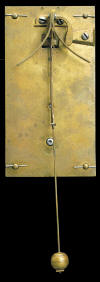
1657
Salomon Coster Haghe met privilege 1657
(N1) Museum
Boerhaave, Leiden
-kopie.png)
1657
Salomon Coster Haghe met privilege 1657
(N2) Collection
Zuylenburgh - Bert Degenaar

1658
Salomon Coster Haghe met privilege 1658
(N5) Collection John
C. Taylor

1658
Salomon Coster Haghe Met privilege
(N4) Science Museum,
London
-kopie.png)
1658
A. Fromanteel London Fecit 1658
“Lyme Park Fromanteel”
Collection The National Trust
%20kopie.png)
1659
A Fromanteel Londini
Collection John C. Taylor

1659
A Fromanteel Londini
“Bass Fromanteel” Private collection
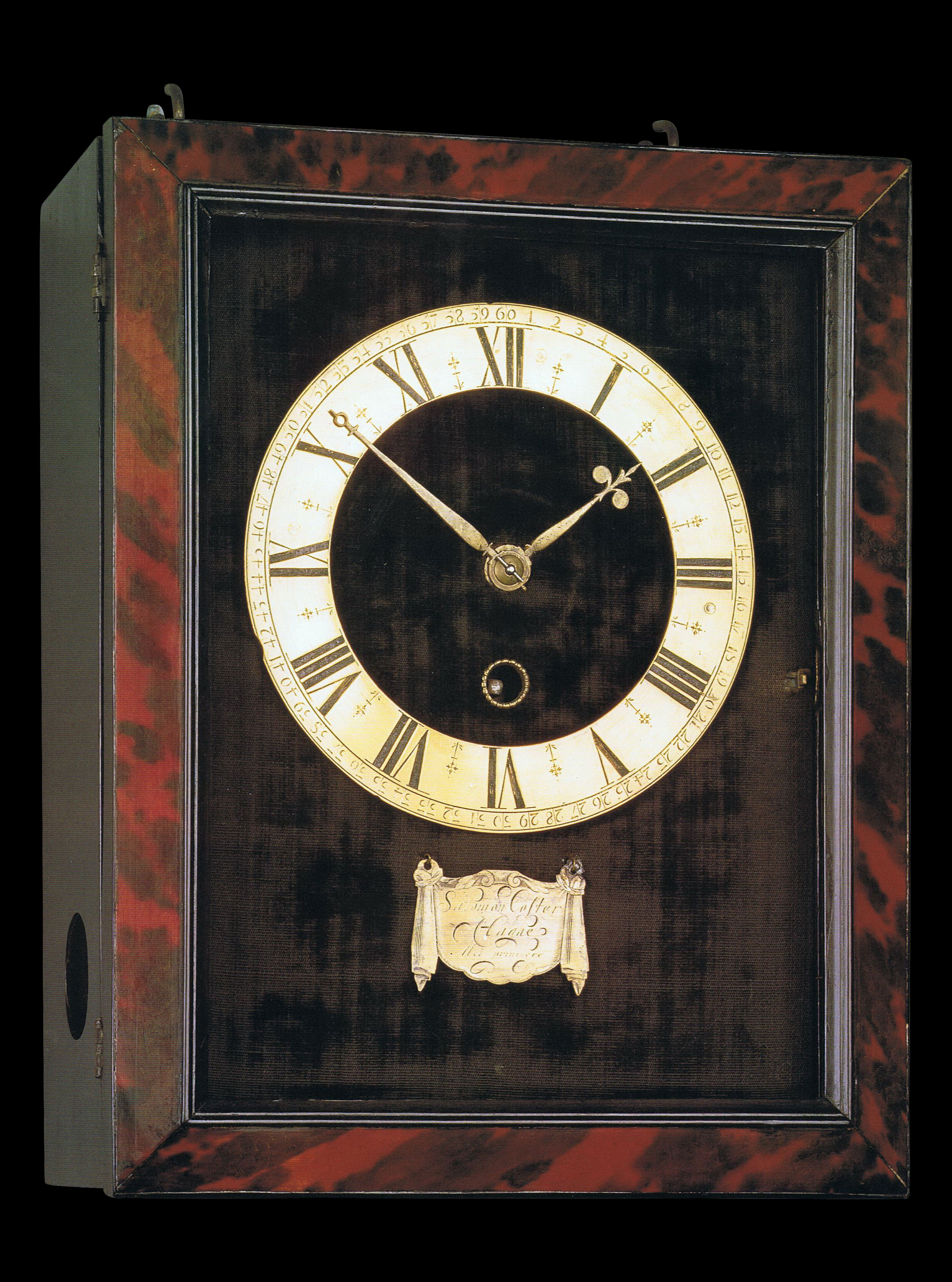
1659
Salomon Coster Haghe Met privilege
(N8) Collection Museum of
the Dutch Clock
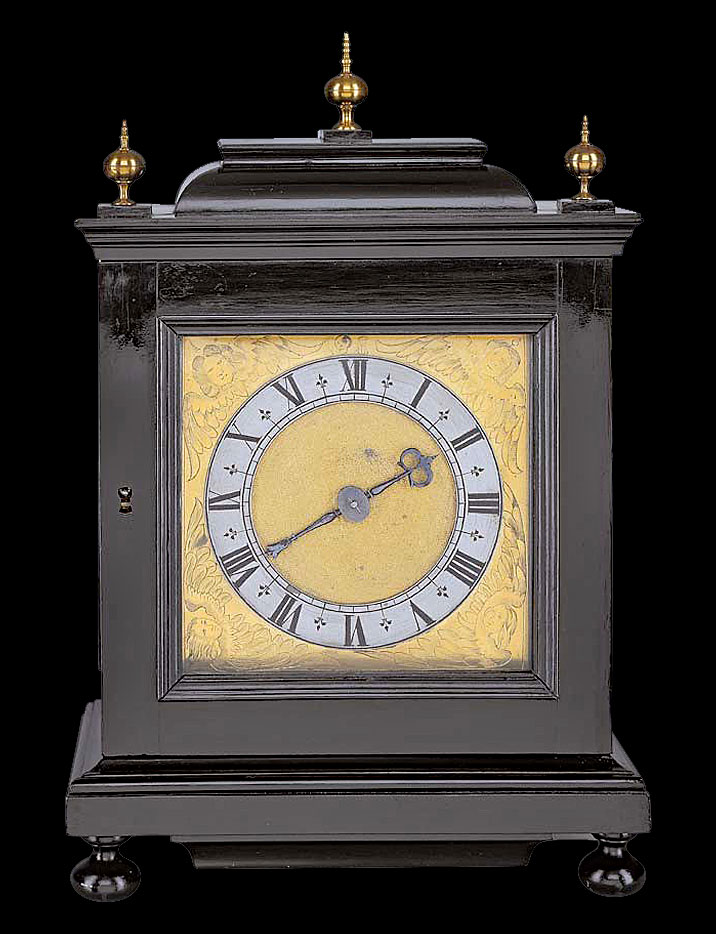
1659
Simon Bartram
Collection John C. Taylor

1659-1660
Salomon Coster Haghe Met privilege
(N10) Former
collection Mario Crijns
-kopie.jpg)
1659-1660
Ahasuerus Fromanteel Londini fecit
Private collection
_1659-1660-kopie.jpg)
1659-1660
Ahasuerus Fromanteel
Londini Fecit
Collection John
C. Taylor
 TIMELINE
TIMELINE
|
25 Feb. 1607
|
Ahasuerus Fromanteel I born in
Norwich
|
|
Ca. 1622 |
Salomon Coster born in Haarlem |
|
14 Apr. 1628
|
Christiaan Huygens born in The
Hague
|
|
1631
-Nov. 1632
|
Ah. Fromanteel I joins the Blacksmiths’ Company and the Clockmakers’
Company as Free Brother
|
|
Nov. 1632
|
Ah. Fromanteel I joins the Clockmakers’ Company by redemption (purchase)
as Free Brother
|
|
Ca. 1638
|
Johannes (John) Fromanteel born
|
|
31 Jan. 1646 |
Salomon Coster is named as a master clockmaker (meester
horologiemaecker)
in a notarial document in which master tailor
Rerick Eraerts entered into a contract with Salomon Coster for the
apprenticeship of his son Pieter Rerick (Visbach). |
|
5 Apr. 1652
|
John Fromanteel is bound before the Court to his father as apprentice
|
|
Jun.
1655 –
Sep. 1656
|
In the run up to the publication in 1656 of
Wallis’ book Arithmetica
infinitorum, Christiaan Huygens and John Wallis have an extensive
correspondence on Mathematics.
At that moment Wallace is
the only Englishman Christiaan is corresponding with.
|
|
28
Jun.1655 –Dec.1655 |
Chr. Huygens is in Paris
(together with his younger brother Lodewijk and cousin Philips Doublet)
|
|
1 Nov. 1655 |
Apprentice contract between Salomon Coster and Christiaen Reynaerts.
|
|
1656 & 1657
|
Chr. Huygens is in Holland (The Hague).
|
|
14 Jan. 1656
|
Ah. Fromanteel I receives the
Freedom of the City of London and subsequently, after intervention of
Cromwell, the Lord Protector, also the Freedom of the Clockmakers’
Company.
|
|
25 Dec. 1656
|
Chr. Huygens invents the
application of the pendulum to the clock.
|
|
1657 1st half
|
Hartlib records,
'Mr Palmer of Gray’s Inn hath Mr. Fosters new invented Dial. A clock of
Fromantils of 200lb who will have ready within 6 weekes his new invented
Clock of Motion to goe without being wound up a weeke or month or
longer'.
|
|
12 Jan. 1657
|
Christiaan Huygens writes his former tutor,
the mathematician Professor Frans van Schooten ‘These
days I found the construction of a clock of a new generation, with times
so exact as the diameter, with its help I have no small hope to be able
to determine the longitude at sea’
|
|
1 Feb. 1657
|
Chr.
Huygens writes to Claude Mylon
‘I
will also share with him1 a new invention, that must be of
great use in astronomy, and that I hope to successfully use finding the
longitudes. You will hear of it soon.’
1
With him is meant Ismaël Boulliau, at that moment secretary of the
French ambassador in The Dutch Republic.
|
|
12 Apr. 1657
|
Claude Mylon writes to
Christiaan Huygens that his invention of the clock is found very
beautiful by all whom he has told about it, and this will be even more
so if Huygens can make it independent of weight or spring. Then nothing
would stand in the way of solving the problem of longitude.
|
|
18 May 1657 |
Claude Mylon writes Huygens that he is glad that Huygens is continuously
perfecting his clock further, he fervently hopes it will be just as good
at sea as in the room and changes from dry to humid do not change it
more than the change in weights. |
|
June 1657 |
Huygens writes and explains to Kechelius how he discovered and invented
the adaptation of the pendulum to a movement. |
|
18 May 1657
|
Claude Mylon writes Huygens that
he is glad that Huygens is continuously perfecting his clock further, he
fervently hopes it will be just as good at sea as in the room and
changes from dry to humid do not change it more than the change in
weights.
|
|
16 Jun.
1657
|
Salomon Coster gains the
privilege by the State General of the Dutch Republic. This means he is
the only one allowed to use and sell a pendulum clock, invented by
Christiaan Huygens and made available to Coster, in the Dutch Republic
for a period of 21 years.
|
|
16 Jul. 1657
|
The States of Holland and West-Friesland officially ratify the patent.
|
|
3 Sep. 1657
|
Contract signed at The Hague, The Netherlands, between John Fromanteel
of London (then still nominally an apprentice to his father) and Salomon
Coster of The Hague. Fromanteel under the contract to remain at Coster's
expense, making horologien, until May 1658
|
|
25 Sept.1657 |
The first delivery of a Coster pendulum clock to the Grand Duke
Ferdinand II de' Medici in Florence. The manufacture of this clock must
have been
completed well before the arrival of John Fromanteel in
Coster’s workshop |
|
22
Dec. 1657 |
Salomon Coster announces in an advert in Tijdinghe uyt verscheyden
Quartieren (22 December 1657, no 51) his pendulum clocks, spring or
weight driven and made according to the patent of 16 June 1657, will be
available soon. Even conversion of public clocks is possible |
|
26 Dec. 1657
|
Christiaan Huygens asks
Boulliau, by then back in Paris, more details about the clock Ferdinando
de' Medici, Grand Duke of Tuscany allegedly had made, which shows a
resemblance to Huygens’ invention and whether this clock also has a
pendulum.
This is also the letter in which Huygens
indicates it was exactly a year ago he made the first model of a
pendulum clock, and he started to show everyone interested the
construction in June 1657.
He also indicates he is busy with the
conversion of the turret clock in Scheveningen; the pendulum is almost 7
meters long and weighs about 20 kilos.
By now he also urges Boulliau not to do
anything in Paris, not by his own instructions or by anyone else’s …
|
|
Dec. 1657 - Jan. 1658 |
Huygens together with Salomon Coster in cooperation with blacksmith
Coenraad Harmenszoon Brouckman is busy with the conversion of the tower
clock in Scheveningen; the pendulum is almost 7 meters long and weighs
about 20 kilos |
|
3 May 1658 |
Salomon Coster in collaboration with Master blacksmith Bartholomeus
Wijnbron was commissioned to convert the turret clock of the Dom church
in
Utrecht to pendulum |
|
1658 early May
|
John Fromanteel departs from Coster's workshop in The Hague
|
|
1658 early summer
|
Hartlib reports ‘A
Clock newly invented in the Low Countries that need only once to bee
wound in 7 days and hath not failed to go exactly for many months
together. It is made without a balance so that it will never change
by any weather? Fromantil hearing of it, is
endeavouring to make the selfe-same Clock. His clock presented to my
Lord Protector is returned upon his owne hands'
|
|
3 Jun. 1658
|
Hartlib letter to Robert Boyle, saying,
'Sir Robert Honeywood, lately
arrived out of the Low Countries, tells of a singular invention found
out there, of a clock that goes most exactly true without a balance,
which needs not to be wound up but once in eight days, the price being
7lb sterling. Mr Palmer, who hath a shop as it were of all manner of
inventions, is to have one shortly: and Fromantile hearing of it gives
out confidently, that he is able to make the like, or rather to exceed
it'
|
|
13 Jun. 1658
|
Christiaan Huygens writes in a
letter to Boulliau that he wants to apply for a patent in Paris too. The
application is prepared by the French ambassador in The Hague, so
Boulliau can present it to the French Chancellor ...
|
|
21 Jun. 1658
|
Boulliau answers Huygens that
the French Chancellor Seguier has refused up to three times his previous
request, as he does not want all French clockmakers coming after him
screaming.
|
|
16 Jul. 1658
|
Simon Douw applies for a patent
for ‘his own invention’. Huygens and Coster together file a lawsuit
against Douw because of infringement of their patent.
|
|
6 Sep. 1658
|
Publication and distribution of Horologium by Christiaan Huygens;
Salomon
Coster is the only clockmaker who receives two copies of
Horologium
|
|
19 Oct. 1658 |
On request of Huygens the State of Gelderland officially ratifies the
patent to
Salomon Coster in collaboration with Jan van Call. (This
patent covers mainly
turret clocks) |
|
28 Oct. 1658
|
Ahasuerus Fromanteel advertises availability
of newly-invented pendulum clocks in
Mercurius Politicus
|
In addition for new and more detailed
information we refer to the publication of Ben Hordijk and Rob Memel
Salomon Coster the clockmaker of Christiaan
Huygens. The production and development of the first pendulum clocks in
the period 1657 – September 1658.
●
John Wallis (Ashford, 22 November 1616
- Oxford, 28 October 1703) was an English mathematician. The most
important of Wallis's works, Arithmetica
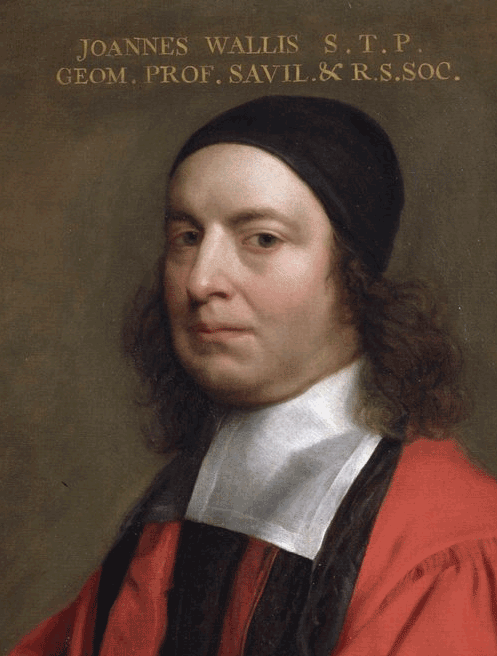 infinitorum, was published in
1656. In this treatise he showed how algebraic methods could be applied
to geometrical situations (after Descartes), like the calculation of the
area under the curve. infinitorum, was published in
1656. In this treatise he showed how algebraic methods could be applied
to geometrical situations (after Descartes), like the calculation of the
area under the curve.
He did preparational work in differential and
integral calculus. Using patterns in finite processes, he sought
formulas for infinite processes. He was an example for many
mathematicians, such as Newton, who built on Wallis' differential and
integral calculus.
●
Samuel Hartlib or Hartlieb (c. 1600 – 10
March 1662) was a versatile German-British scientist. As an active
promoter and expert writer in many fields, he was interested in science,
medicine, agriculture, politics and education. Hartlib had the
purpose of "registering all human knowledge and making it available for
study to all mankind". Before that, he had contact with anyone in the
age of the Commonwealth who meant intellectual matters and was
responsible for patents, disseminating information and promoting
education, passing on designs for calculators, double-script
instruments, seed machines and siege machines. His letters, in German
and English, are still the subject of study ... Hartlib had the
purpose of "registering all human knowledge and making it available for
study to all mankind". Before that, he had contact with anyone in the
age of the Commonwealth who meant intellectual matters and was
responsible for patents, disseminating information and promoting
education, passing on designs for calculators, double-script
instruments, seed machines and siege machines. His letters, in German
and English, are still the subject of study ...
●
Cornelis Jacobszoon Drebbel (1572 – 7
November 1633) was a Dutch engineer and inventor. He was the builder of
the first navigable submarine in 1620 and an innovator who contributed
to the development of measurement and control systems, optics,
chemistry, and the ‘perpetuum mobile’, a device with eternal movement.
In 1598 he obtained a patent for a water-supply system and a sort of
perpetual clockwork.
Around 1605 the Drebbel family moved to England,
probably at the invitation of the new king, James I of England (VI of
Scotland). He was accommodated at Eltham Palace. Drebbel worked there at
the masques, that were perf ormed by and for the court. He was attached
to the court of young Renaissance crown-prince Henry. He astonished the
court with his inventions. ormed by and for the court. He was attached
to the court of young Renaissance crown-prince Henry. He astonished the
court with his inventions.
Between 1610 and 1613 Drebbel resides on
invitation of Rudolf II at the court in Prague.
When Rudolf II was
stripped of all effective power by his younger brother Archduke
Matthias, Drebbel was imprisoned for about a year. After Rudolf's death
in 1612, Drebbel was eventually set free and went back to London.
In
1619 Drebbel showed a composite microscope to the Dutch ambassador in
London, Willem Boreel.
When in England, Constantijn Huygens, father
of Christiaan, was a regular visitor to Drebbel. Between 1618 and 1624
Huygens sr. visited England several times, as a diplomat in training.
From Drebbel he bought a camera obscura and a microscope.
Constantijn
Huygens transferred his interest in optics to his two oldest sons.
Christiaan had a booklet from Drebbel.
After the death of King James
I, Drebbel was employed in the service of the navy between 1626 and 1628
by Charles I, but without much success. As a result of which he lost his
job and income in 1628. Towards the end of his life, Drebbel was working
as innkeeper and brewer. He died in 1633.
●
Rules of the Worshipful Company of Clockmakers

Minimum
age ‘apprenticeship’ is 14 years. Duration of the ‘apprenticeship’ is
7 years. After completion of the 7th year ‘apprenticeship’ the
apprentice becomes a ‘journeyman’ for a period of minimum 2 years
After the ‘journeyman’ period the ‘journeyman’ can become a ‘Freeman’ by
paying the ‘entry fee’.
During the ‘apprenticeship’ the apprentice is
bound to his ‘master’, but is allowed to service another ‘master’ during
this period. In the ‘journeyman’ period the ‘journeyman’ had to work
for one single ‘master’ as ‘workman’, for a period of 2 years, before he
could set up a business himself. During the ‘apprenticeship’ and
‘journeyman’ periods he is not allowed to sign under his own name, the
clock had to be signed under the name of the 'master' that was served.
 ACKNOWLEDGEMENTS ACKNOWLEDGEMENTS
March
2019, Copyright:
(This article is subject to ongoing
revisions.)
 LINKS
and FURTHER READING LINKS
and FURTHER READING
Chr.
Huygens' Œuvres Complètes.
(pdf)
Chr.
Huygens Horologium 1658.
(pdf)
Salomon Coster the clockmaker of Christiaan
Huygens. The production and development of the first pendulum clocks in
the period 1657 – September 1658.
|
|
Notes
continued: |
|
|
|
|
33 |
Oevres Complètes de Christiaan Huygens, Tome Deuxième, correspondance
1657-1659, Martinus Nijhoff, 1889, Appendice II bij No. 523 |
|
34 |
Oevres Complètes de Christiaan Huygens, Tome Deuxième, correspondance
1657-1659, Martinus Nijhoff, 1889, Appendice III bij No. 523 |
|
35 |
Oevres Complètes de Christiaan Huygens, Tome Deuxième, correspondance
1657-1659, Martinus Nijhoff, 1889, No. 443 |
|
36 |
Haags Gemeentearchief - Toegangsnummer Oud notarieel 0372-01, inv. 322,
fol. 409.
Archive research
and transcription performed by Victor Kersing and Rob Memel. |
| 37 |
Rebecca Pohancenik, "The Intelligencer and the Instrument Maker: Early
communications in the development of the pendulum clock", Antiquarian
Horology, Volume 31 no 6, (December 2009), 753. |
|
38 |
The works of the Honourable Robert Boyle, ed T. Birch (London. 1744),
Vol. VI, pp.110-11. In this article I made use of the work and the
article of Rebecca Pohancenik, "The Intelligencer and the Instrument
Maker: Early communications in the development of the pendulum clock",
Antiquarian Horology, Volume 31 no 6, (December 2009), 754. |
|
39 |
Mercurius Politicus, issue number 439, October 21-28, 1658; as
reproduced in Penney, op.cit., 619-620.
In this article I made use of the work and the article of
David Penney, "The Earliest Pendulum Clocks:
A Re-Evaluation", Antiquarian Horology, Volume 31 No 5, (September
2009), 614-620. |
|
40 |
Haags Gemeentearchief - Toegangsnummer Oud notarieel 0372-01, inv. 322,
fol. 409.
Archive research
and transcription performed by Victor Kersing and Rob Memel. |
|
41 |
..te weten dat hij Fromanteel orologie…. zal voltrecken en
volmaecken. |
|
42 |
Haags Gemeentearchief - Toegangsnummer Oud notarieel 0372-01, inv. 20,
fol. 321.
Archive research
and transcription performed by Victor Kersing and Rob Memel. |
|
43 |
Haags Gemeentearchief - Toegangsnummer Oud notarieel 0372-01, inv. 110,
fol. 63.
Archive research
and transcription performed by Victor Kersing and Rob Memel. |
|
44 |
R. Plomp, "Spring-driven Dutch pendulum clocks 1657-1710", Interbook
(Schiedam), 1979, 15 |
|
45 |
Oevres Complètes de Christiaan Huygens, Tome Troisième, correspondance
1660-1661, Martinus Nijhoff, 1889 No. 852 note
1 |
|
46 |
John Evelyn, "The Diary of John Evelyn", 1901, 346 |
|
47 |
Oevres Complètes de Christiaan Huygens, Tome Troisième, correspondance
1660-1661, Martinus Nijhoff, 1889, No. 868 |
|
48 |
Oevres Complètes de
Christiaan Huygens, Tome Deuxième, correspondance 1657-1659, Martinus
Nijhoff, 1889, No. 452 |
| 49 |
Christiaan Huygens, "Horologium Oscilatorum", 1673, Pars Prima |
|
50 |
“Briefwisseling van
Constantijn Huygens” edited by J.A. Worp (old edition) - Part 1,
1608-1634, GS 15 p. LIV |
|
51 |
Worsley to Hartlib, 22 June 1648, HP 42/1/1 A. In this article I made
use of the work and the article of Rebecca Pohancenik, "The
Intelligencer and the Instrument Maker: Early communications in the
development of the pendulum clock", Antiquarian Horology, Volume 31 no
6, (December 2009), 750. |
|
52 |
Richard Garnier & Leo Hollis, "Innovation & Collaboration, The early
development of the pendulum clock in London", 2018, 144. |
|
|
|

|









-kopie.png)


-kopie.png)
%20kopie.png)




-kopie.jpg)
_1659-1660-kopie.jpg)
 infinitorum, was published in
1656. In this treatise he showed how algebraic methods could be applied
to geometrical situations (after Descartes), like the calculation of the
area under the curve.
infinitorum, was published in
1656. In this treatise he showed how algebraic methods could be applied
to geometrical situations (after Descartes), like the calculation of the
area under the curve.  Hartlib had the
purpose of "registering all human knowledge and making it available for
study to all mankind". Before that, he had contact with anyone in the
age of the Commonwealth who meant intellectual matters and was
responsible for patents, disseminating information and promoting
education, passing on designs for calculators, double-script
instruments, seed machines and siege machines. His letters, in German
and English, are still the subject of study ...
Hartlib had the
purpose of "registering all human knowledge and making it available for
study to all mankind". Before that, he had contact with anyone in the
age of the Commonwealth who meant intellectual matters and was
responsible for patents, disseminating information and promoting
education, passing on designs for calculators, double-script
instruments, seed machines and siege machines. His letters, in German
and English, are still the subject of study ... ormed by and for the court. He was attached
to the court of young Renaissance crown-prince Henry. He astonished the
court with his inventions.
ormed by and for the court. He was attached
to the court of young Renaissance crown-prince Henry. He astonished the
court with his inventions.